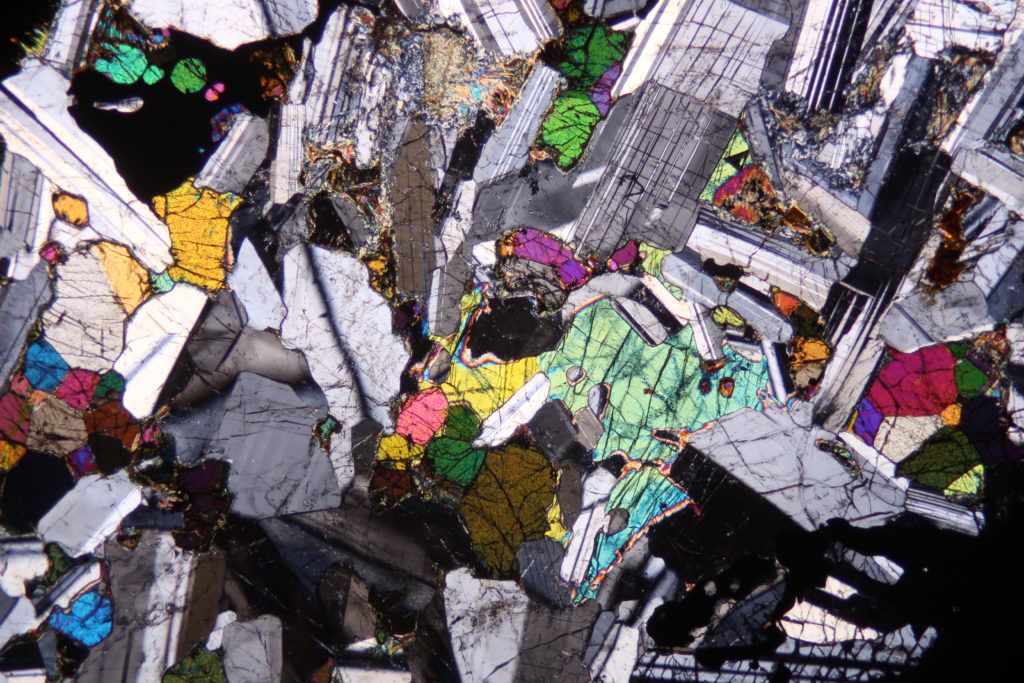Celebrating the art of science is something the University of Wisconsin-Madison Cool Science Image Contest has been doing since its inception 10 years ago as part of The Why Files. The 2020 winning images include entries as diverse as videos of neural stem cells, eye-ball licking geckos and yes, even a picture of rock: actually a thin section of tractolite, an igneous rock composed of feldspar and olivine collected near Duluth Minnesota form the Proterozoic Mid-continent Rift. This image was collected by Natalie Betz, PhD, Associate Director of the UW-Madison Master of Science in Biotechnology program and her daughter Anya Wolterman, a recent graduate of Macalester College with degrees in Geology and Physics. Natalie has a long-time connection with Promega and the BioPharmaceutical Technology Center Institute, so we reached out to her to get the perspective of a contest entrant. Natalie is answering for both her and her daughter while her daughter is away doing some trail maintenance in the Rockies and is not available for comment.

Promega Connections: Why did you decide to enter the UW Cool Science Image contest?
Natalie: I entered her [Anya’s] geology picture from her senior capstone honors project at Macalester College because I thought it was so beautiful. She had generated several images during the project, but this one was particularly striking because of the multiple colors and shapes. I also entered the image because we both love rocks—I have a hobby interest in geology and paleontology, and if the two of us are anywhere together, we always pick up cool rocks that we find—our eyes are on the ground searching for anything unusual.
Promega Connections: Tell us about the project that led to this image.
Natalie: [Anya] had to do a final research project for her undergraduate degree in geology. The project involved analyzing very thin slices of samples of rocks collected in Baja California by her supervising professor (Dr. Alan Chapman). The goal of the project was to analyze the composition of rock samples to determine their origin and age to further elucidate the plate tectonic movement of that region of the country. The images were generated on a special type of microscope that utilized polarized light. Different types of rock produce different refraction patterns and colors.
Promega Connections: Why do you think SciArt projects like the UW Cool Science Image are important?
Natalie: I think images of science can capture the imagination of scientists and non-scientists alike—promoting education and understanding of diverse areas of research. Images can capture everyone’s attention, and then can draw you into discovering what the image is, how was it generated, and what does it mean. They make learning more engaging and captivating.
This year’s winners include a slice of the oldest dated stalagmite in the Midwest, weather images across the earth and a flower model for imaging breast cancer calcifications. These images capture the massive to the minute, from galaxies to microscopic leg hairs on a newly described species of arachnid in Papua New Guinea. They communicate curiosity, awe and an understanding of a natural world in a way that no scientific manuscript (or even popular science article) ever could.
Read more about art work and other community projects that Promega sponsors as part of its corporate responsibility program.
Related Posts
Michele Arduengo
Latest posts by Michele Arduengo (see all)
- An Unexpected Role for RNA Methylation in Mitosis Leads to New Understanding of Neurodevelopmental Disorders - March 27, 2025
- Unlocking the Secrets of ADP-Ribosylation with Arg-C Ultra Protease, a Key Enzyme for Studying Ester-Linked Protein Modifications - November 13, 2024
- Exploring the Respiratory Virus Landscape: Pre-Pandemic Data and Pandemic Preparedness - October 29, 2024
